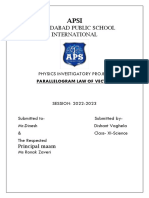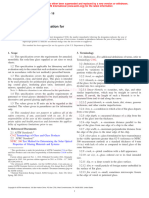Helical Spring Experiment
Uploaded by
Sandeep KumarHelical Spring Experiment
Uploaded by
Sandeep KumarEXPERIMENT 2
AIM
To find the force constant of a helical spring by plotting graph between load and
extension.
WHAT YOU REQUIRE
A long 30 cm) spring made of thin tempered steel
(about
wire; an iron stand with a heavy base, nearly
long rod and two clamps; pointer-maybe a of
1 m
just piece rigid metal wire; feviquick; a half metre a
with 6-7 slotted weights of 20 rule;
hanger
g each; a mirror strip and a of pair pliers.
HOW TO SET-UP THE APPARATUS
)Place the iron-stand on the table.
(i) Fix the half metre rule
vertically in the clamps.
(üi)
Straighten nearly 2-3 cm
length of spring on either end and firmly fix its one end on
rod with the the upper
help of pliers so that it hangs clamp
vertically on the clamp. Secure its
drops of feviquick. position by putting a few
v) Onthe lower end of the
spring, fix the hanger in a similar manner.
(o) Attach the
pointer just above the hanger on the
straight portion of the spring with the help of
so that it freely moves
just in front of the scale. Ensure
that the pointer is horizontal
feviquick
and the spring are vertical. whereas the scale
Rigid support
Vertica
Scale
Spring
Pointer
Slotted
weights
Fig. B-2.1. Experimental set-up for load extension graph of a helical spring
THEORY
Spring constant a spring 1s the restoring force
of
per unit extension in the
spring.
When upper end of a spring held
vertically is fixed and load is
applied at its lower end, there is an
in its length which increases with the increase in inerease
load.
i.e., load (F) extension (y)
104 Tagether uith Physics Lab Manual-11
proportionality R, called force
The constant constant or spring
SI unit
N m-1 constant, has dimensional formula mi
MT
and
kythe graph betw
ween F and y will be a
straight line and slope of the aph
graph will give the value of k.
TEMATIC STEPS TO PERFORM THE EXPERIMENT
, With hanger attached to the
spring note down the initial
hat there is no error due to parallax in position of the pointer on the scale. To ensure
recording position of the pointer. You can hold a
hehind the scale and holding your plane mirror
behi eyes in such a
position that pointer covers its mirror
Put 20 g weight on the hanger and let the spring
image.
stay in equilibrium. Note the position of the pointer
again.
3. Go on adding 20 g weights on the hanger and noting the corresponding
readings this way. positions of pointer. Take eight
4 Decrease load in steps o 20 g weight and note the
corresponding positions of pointer on vertical scale
again.
OBSERVATION
Least count of vertical scale = cm
TABLE FOR EXTENSION OF SPRING UNDER
DIFFERENT LOADS
Positio of pointer on the vertical scale
(cm mark)
S.No.L0ad on hanger
WgA Load increasing Load decreasing
() -
Mean
I-y,
=
Extension
(em)
2.
20
3.
40
4.
60
5.
80
6.
100
7
120
8.
140
GRAPH
cording to the
range of data and the dimensions of the graph paper available decide suitable seales
for load and extension.
aSection B: Experiments 105
on x-axis.
and extension
). taking load
ony-axis
ag
8aph
2. Plot
The graph will
between load
be a straight
(W) and extension
line as shown in Fig. B-2.2.
x
C
Extension (cm)-
extension for a helical spring
Fig. B-2.2. Load graph
CALCULATION
k
slopeof straight line =tan AG CD
g
cm
9.8x10
10 m
N= x 0.098 N m-.
RESULT
1. The load extension graph for the given helical spring is a straight line as shown in Fig. B-2.2.
2. The value
of spring
constant for the given spring is Nm
PRECAUTIONS
1. Do not load the spring too much or otherwise it may get stretched permanently.
2. The support of the spring should be rigid and it should be firmly secured with it.
3. Put weights on the hanger gently and wait a while after changing weights so that it may reach
its
equilibrium state.
4. The pointer should be horizontal. It should move just in front of the vertical scale freely.
sOURCES OF ERROR
1. The clamp from which you suspended the spring may yield slightly under the load.
2. The values marked on slotted weights may not indicate their true mass.
VIVA VOCE
What does graph between
Q.1.
and extension
the straight
line load
Q4. On what factors does the foree constant ofa
imply? spring depend?
Ans. It implies that extension is directly proportional| Ans. On Young's modulus of elasticity of the mater
)
to load. of the wire the is made on the lengtn
spring of,
Q.2. Which law of physics
does it correspond to?2 and area of cross-section of the
spring8
Ans. Hooke's law of Q.5. How?
Y(i)k A
elasticity
Q.3. Does the law hold for any value of load? Ans. k « (ii) k
within limit what
two
Ans. No, it is applicable of elasticity forQ.6. If a spring is cut into
equal parts,
the force constant with to
the spring of each part respec
the original
spring?
106 Physics Lab Manual-11
7agether with
Ans. If the force constant of original spring is k, the
force constant of each half would be 2k.
Q.7. Can you explain how?
Ans. The extension is directly proportional to the length k,
of the spring. For the full spring extension is
y,
k under the same mas8 on a spring and
then =y,for the half spring Q12.When a is pulled let go,
force extension is ie,k = y/2
= 2P 2. what type
Ans. Simple
of motion does
harmonic motion.
it execute?
Q.8. Ifthe two halves are joined in parallel, what
will9.13.What is the formula for the time period of these
be the force constant of the combination?
oscillations?
Ans. 2k.
m
Q.9. Explain the answer of Q.8.
Ans.T=2it
Ans. If load applied is F, it will be equally shared by Q.14.Can you mention any use of the experiment you
=
the two parts and both parts will undergo equal performed?
extension. Ans. The linear relation between load and extension
Total force = 2F and total extension = y.
forms the principle of working of a spring
k= 2k.
balance.
Q.15.If you are given a spring, a known weight, a
Q.10.If two springs of foree constants k, and k, are
stopwatch and a metre scale, how can you find
joined in series, what will be the force constant the mass of a body of unknown mass?
of the combination?
Ans. Suspending the known weight to the spring and
k k,k measuring extension, we can find k. Then setting
Ans.
k,+k,) the spring into oscillations with unknown mass,
Q.11.Please explain. we can find its time period of oscillations. Using
Ans. In series, the total extension will be equal to the T'k
sum of the extensions in individual spring.
relation,
mass.
m =
4T2Wecan calculate unknown
1.e.
You might also like
- Searles Experiment To Determine The Young Modulus0% (2)Searles Experiment To Determine The Young Modulus3 pages
- Magnetic Field Along The Axis of A Circular Coil Carrying Current0% (1)Magnetic Field Along The Axis of A Circular Coil Carrying Current5 pages
- Physics Lab Manual - Class 11 Experiment No. 4No ratings yetPhysics Lab Manual - Class 11 Experiment No. 44 pages
- Class - Xi and Xii Physics Practical List Session - 2024-25No ratings yetClass - Xi and Xii Physics Practical List Session - 2024-254 pages
- To Find The Weight of A Given Body Using Parallelogram Law of Vectors100% (2)To Find The Weight of A Given Body Using Parallelogram Law of Vectors5 pages
- To Determine The Mass of A Given Body Using A Metre Scale80% (5)To Determine The Mass of A Given Body Using A Metre Scale13 pages
- Experiment - 1: Aim: To Determine The Least Count of The Vernier Callipers and Measure The Length and Diameter of A Small Cylinder. Apparatus100% (1)Experiment - 1: Aim: To Determine The Least Count of The Vernier Callipers and Measure The Length and Diameter of A Small Cylinder. Apparatus7 pages
- Decrease in Pressure With Increase in Velocity of A Fluid100% (3)Decrease in Pressure With Increase in Velocity of A Fluid2 pages
- Physics Lab Manual - Class 11 Experiment No. 3100% (1)Physics Lab Manual - Class 11 Experiment No. 33 pages
- Suggested Investigatory Projects - Class-1150% (4)Suggested Investigatory Projects - Class-112 pages
- Experiment: Apparatus:: To Find The Modulus of Rigidity of Copper Wire Using Maxwell's Needle50% (2)Experiment: Apparatus:: To Find The Modulus of Rigidity of Copper Wire Using Maxwell's Needle2 pages
- Physics - Practical Record Writing - Class XI100% (2)Physics - Practical Record Writing - Class XI83 pages
- To Determine Specific Heat Capacity of A Given Solid by Method of Mixtures Ex. No. Date: AimNo ratings yetTo Determine Specific Heat Capacity of A Given Solid by Method of Mixtures Ex. No. Date: Aim5 pages
- Gaurav Singh Parallelogram Law of VectorsNo ratings yetGaurav Singh Parallelogram Law of Vectors23 pages
- Calibration of Voltmeter by PotentiometerNo ratings yetCalibration of Voltmeter by Potentiometer4 pages
- Formula Sheet - Mechanical Properties of Fluids50% (2)Formula Sheet - Mechanical Properties of Fluids3 pages
- Verification of Hookes Law - Physics Astronomy Project Topics100% (2)Verification of Hookes Law - Physics Astronomy Project Topics7 pages
- Abhishek Thakur Xi-F 15 Physics Project File: Mechanical Properties of FluidsNo ratings yetAbhishek Thakur Xi-F 15 Physics Project File: Mechanical Properties of Fluids14 pages
- Experiment - To Find The Speed of Sound in Air at Room Temperature Using A Resonance Tube by Two Resonance Positions100% (1)Experiment - To Find The Speed of Sound in Air at Room Temperature Using A Resonance Tube by Two Resonance Positions1 page
- Created by C. Mani, Education Officer, KVS RO Silchar: ST ND RD ST ND RD ST ND RD100% (2)Created by C. Mani, Education Officer, KVS RO Silchar: ST ND RD ST ND RD ST ND RD51 pages
- Mechanics: Expansion of A Helical SpringNo ratings yetMechanics: Expansion of A Helical Spring2 pages
- MX2 Training Program 10G VerifyExitAngleDelay On IIWNo ratings yetMX2 Training Program 10G VerifyExitAngleDelay On IIW21 pages
- Suspended Systems: Lighting and SecurityNo ratings yetSuspended Systems: Lighting and Security8 pages
- 193 Department of Mechanical EngineeringNo ratings yet193 Department of Mechanical Engineering6 pages
- An Experimental Study of The Polycrystalline Plasticity ofNo ratings yetAn Experimental Study of The Polycrystalline Plasticity of18 pages
- A Memristor Model With Peicewise Window FunctionNo ratings yetA Memristor Model With Peicewise Window Function6 pages
- Uniform-Sense Normal Simple Shear of The Continental Lithosphere100% (1)Uniform-Sense Normal Simple Shear of The Continental Lithosphere18 pages
- Numerical Simulation of Transonic Flow Past A Cropped Delta WingNo ratings yetNumerical Simulation of Transonic Flow Past A Cropped Delta Wing6 pages
- Microsoft PowerPoint - 06-Gas Well Testing - PPT (Read-Only)No ratings yetMicrosoft PowerPoint - 06-Gas Well Testing - PPT (Read-Only)14 pages
- Non-Isothermal Kinetic and Thermodynamic Studies of The Dehydroxylation Process of Synthetic Calcium Hydroxide Ca (OH) 2No ratings yetNon-Isothermal Kinetic and Thermodynamic Studies of The Dehydroxylation Process of Synthetic Calcium Hydroxide Ca (OH) 211 pages
- Probability, Statistics & Queueing Theory (R22a0026)No ratings yetProbability, Statistics & Queueing Theory (R22a0026)120 pages
- Twisted Tube Heat Exchanger Inspection With Eddy Currents 1629310798No ratings yetTwisted Tube Heat Exchanger Inspection With Eddy Currents 16293107982 pages
- Pile Analysis (As2159) in Accordance With Australian Standard: Piling-Design and Installation Per AS 2159-2009No ratings yetPile Analysis (As2159) in Accordance With Australian Standard: Piling-Design and Installation Per AS 2159-20093 pages
- Approximate Traveling Wave Solution of Avian FluNo ratings yetApproximate Traveling Wave Solution of Avian Flu6 pages
- Model Predictive Control For DC Motors: Lafta E. J. Alkurawy Nisreen KhamasNo ratings yetModel Predictive Control For DC Motors: Lafta E. J. Alkurawy Nisreen Khamas6 pages
- Instant download Optics Photonics and Laser Technology 2017 Paulo Ribeiro pdf all chapter100% (3)Instant download Optics Photonics and Laser Technology 2017 Paulo Ribeiro pdf all chapter55 pages
- Magnetic Field Along The Axis of A Circular Coil Carrying CurrentMagnetic Field Along The Axis of A Circular Coil Carrying Current
- Class - Xi and Xii Physics Practical List Session - 2024-25Class - Xi and Xii Physics Practical List Session - 2024-25
- To Find The Weight of A Given Body Using Parallelogram Law of VectorsTo Find The Weight of A Given Body Using Parallelogram Law of Vectors
- To Determine The Mass of A Given Body Using A Metre ScaleTo Determine The Mass of A Given Body Using A Metre Scale
- Experiment - 1: Aim: To Determine The Least Count of The Vernier Callipers and Measure The Length and Diameter of A Small Cylinder. ApparatusExperiment - 1: Aim: To Determine The Least Count of The Vernier Callipers and Measure The Length and Diameter of A Small Cylinder. Apparatus
- Decrease in Pressure With Increase in Velocity of A FluidDecrease in Pressure With Increase in Velocity of A Fluid
- Experiment: Apparatus:: To Find The Modulus of Rigidity of Copper Wire Using Maxwell's NeedleExperiment: Apparatus:: To Find The Modulus of Rigidity of Copper Wire Using Maxwell's Needle
- To Determine Specific Heat Capacity of A Given Solid by Method of Mixtures Ex. No. Date: AimTo Determine Specific Heat Capacity of A Given Solid by Method of Mixtures Ex. No. Date: Aim
- Verification of Hookes Law - Physics Astronomy Project TopicsVerification of Hookes Law - Physics Astronomy Project Topics
- Abhishek Thakur Xi-F 15 Physics Project File: Mechanical Properties of FluidsAbhishek Thakur Xi-F 15 Physics Project File: Mechanical Properties of Fluids
- Experiment - To Find The Speed of Sound in Air at Room Temperature Using A Resonance Tube by Two Resonance PositionsExperiment - To Find The Speed of Sound in Air at Room Temperature Using A Resonance Tube by Two Resonance Positions
- Created by C. Mani, Education Officer, KVS RO Silchar: ST ND RD ST ND RD ST ND RDCreated by C. Mani, Education Officer, KVS RO Silchar: ST ND RD ST ND RD ST ND RD
- MX2 Training Program 10G VerifyExitAngleDelay On IIWMX2 Training Program 10G VerifyExitAngleDelay On IIW
- An Experimental Study of The Polycrystalline Plasticity ofAn Experimental Study of The Polycrystalline Plasticity of
- Uniform-Sense Normal Simple Shear of The Continental LithosphereUniform-Sense Normal Simple Shear of The Continental Lithosphere
- Numerical Simulation of Transonic Flow Past A Cropped Delta WingNumerical Simulation of Transonic Flow Past A Cropped Delta Wing
- Microsoft PowerPoint - 06-Gas Well Testing - PPT (Read-Only)Microsoft PowerPoint - 06-Gas Well Testing - PPT (Read-Only)
- Non-Isothermal Kinetic and Thermodynamic Studies of The Dehydroxylation Process of Synthetic Calcium Hydroxide Ca (OH) 2Non-Isothermal Kinetic and Thermodynamic Studies of The Dehydroxylation Process of Synthetic Calcium Hydroxide Ca (OH) 2
- Probability, Statistics & Queueing Theory (R22a0026)Probability, Statistics & Queueing Theory (R22a0026)
- Twisted Tube Heat Exchanger Inspection With Eddy Currents 1629310798Twisted Tube Heat Exchanger Inspection With Eddy Currents 1629310798
- Pile Analysis (As2159) in Accordance With Australian Standard: Piling-Design and Installation Per AS 2159-2009Pile Analysis (As2159) in Accordance With Australian Standard: Piling-Design and Installation Per AS 2159-2009
- Model Predictive Control For DC Motors: Lafta E. J. Alkurawy Nisreen KhamasModel Predictive Control For DC Motors: Lafta E. J. Alkurawy Nisreen Khamas
- Instant download Optics Photonics and Laser Technology 2017 Paulo Ribeiro pdf all chapterInstant download Optics Photonics and Laser Technology 2017 Paulo Ribeiro pdf all chapter





























































































